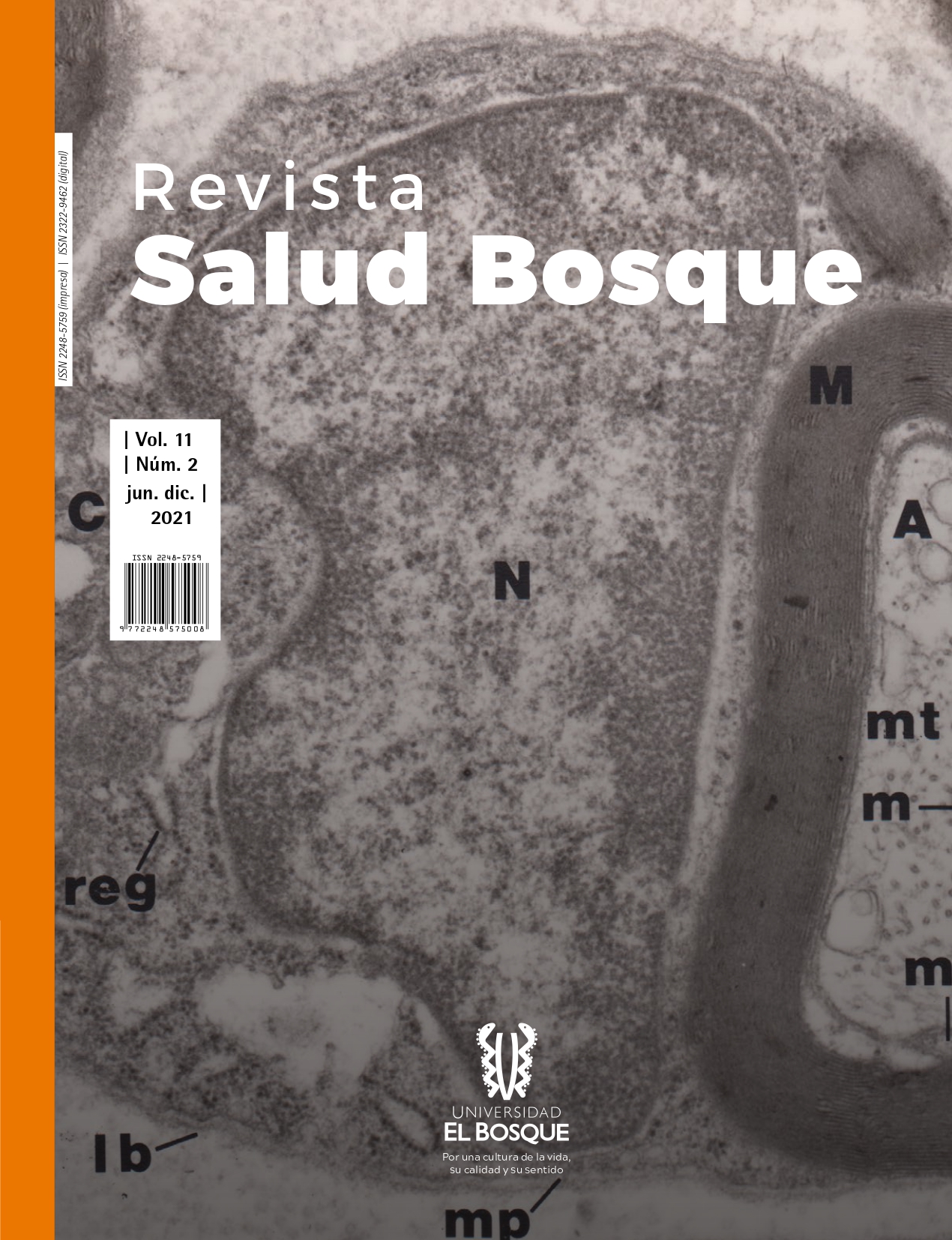The Experience in Training Sessions and Skin Cancer Detection in Rural Areas of Colombia
DOI:
https://doi.org/10.18270/rsb.v11i2.3573Keywords:
Education, basal cell carcinoma, squamous cell carcinoma, melanoma, screeningAbstract
Introduction: Skin cancer is a public health problem that has been growing over the past years with the basal cell carci- noma being the most frequent followed by the squamous cell and melanoma with least incidence and high mortality rate.
Objective: To describe a continuous education experience and early detection of skin cancer in seven Colombian regions in 2019 by the National Institute of Cancerology.
Materials and methods: a descriptive, observational, cross-sectional study in which 151 health professionals were trained and treated 349 patients residing in Vichada, Chocó, Guajira, Cesar, Guaviare, Caquetá and Boyacá from March 19 to December 4 of the same year.
Results: The brigades diagnosed 32 skin cancer cases, 62% were women, 38% men, 97% were affiliated with the subsi- dized regime with an average age of 70 years old. The basal cell carcinoma was the most common with 24 cases (49%), followed by the squamous cell carcinoma with 7 cases (14%) and the melanoma with 1 case (2%).
Conclusions: The results of continuous training directed to healthcare professionals are crucial for the early detection of this disease. These programs allowed diagnosing melanoma and non-melanoma skin cancer at an early stage on the treated population. In addition, they proved the lack of this type of actions in contexts where there are access barriers to specialized medical attention.
Downloads
References
Lomas A, Leonardi-Bee J, Bath-Hextall F. A systematic review of worldwide incidence of nonme- lanoma skin cancer. Br J Dermatol. 2012;166(5):1069–80. DOI: 10.1111/j.1365-2133.2012.10830.x
Rogers HW, Weinstock MA, Feldman SR, Coldiron BM. Incidence estimate of nonmelano- ma skin cancer (keratinocyte carcinomas) in the US population, 2012. JAMA Dermatol. 2015 Oct;151(10):1081-6. DOI: 10.1001/jamadermatol.2015.1187
Sánchez G, Nova J. Factores de riesgo de carcinoma espinocelular, un estudio del Centro Na- cional de Dermatología de Colombia. Actas Dermosifiliogr. 2013;104(8):672–8. DOI: https://doi.org/10.1016/j.ad.2013.01.005.
Instituto Nacional de Cancerología (INC). Anuario estadístico 2020. Bogotá, D. C.: INC; 2021. https://www.cancer.gov.co/recursos_user/files/libros/archivos/Anuario_INC_2020-_19_NOV.pdf
Kim DP, Kus KJB, Ruiz E. Basal cell carcinoma review. Hematol Oncol Clin North Am. 2019; 33(1):13-24. DOI: 10.1016/j.hoc.2018.09.004
Verkouteren JAC, Ramdas KHR, Wakkee M, Nijsten T. Epidemiology of basal cell carcinoma: scholarly review. Br J Dermatol. 2017;177(2):359–72. DOI: 10.1111/bjd.15321
Cameron MC, Lee E, Hibler BP, Barker CA, Mori S, Cordova M, Nehal KS, Rossi AM. Basal cell carcinoma: Epidemiology; pathophysiology; clinical and histological subtypes; and disease as- sociations. J Am Acad Dermatol. 2019; 80(2):303-17.
DOI: 10.1016/j.jaad.2018.03.060
Miller DL, Weinstock MA. Nonmelanoma skin cancer in the United States: Incidence. J Am Acad Dermatol. 1994;30 (5 Pt 1):774–8. DOI: 10.1016/s0190-9622(08)81509-5
Karia PS, Han J, Schmults CD. Cutaneous squamous cell carcinoma: Estimated incidence of disease, nodal metastasis, and deaths from disease in the United States, 2012. J Am Acad Dermatol. 2013;68(6):957–66. DOI: 10.1016/j.jaad.2012.11.037
Kim C, Cheng J, Colegio OR. Cutaneous squamous cell carcinomas in solid organ transplant reci- pients: emerging strategies for surveillance, staging, and treatment. Semin Oncol. 2016 ;43(3):390-4. DOI: 10.1053/j.seminoncol.2016.02.019
International Agency for Research on Cancer (IARC). Cancer today [sede Web]*. Francia: Can- cer today -IARC. Data visualization tools for exploring the global cancer burden in 2019. https://gco.iarc.fr/today/home
Owens B. Melanoma. Nature. 2014; 515(7527):S109. DOI: 10.1038/515S109a
Hollestein LM, van den akker SAW, Nijsten T, Karim-kos HE, Coebergh JW, de vries E. Trends of cutaneous melanoma in the Netherlands: Increasing incidence rates among all breslow thick- ness categories and rising mortality rates since 1989. Ann Oncol. 2012;23(2):524–30. DOI: 10.1093/annonc/mdr128
Pardo-Ramos C, Cendales-Duarte R. Incidencia, mortalidad y prevalencia de cáncer en Colom- bia, 2007-2011. 1ª ed. Bogota: Instituto Nacional de Cancerología. 2015.
Sistema de informacion de cancer en Colombia. Estadistica-Incidencia-Melanoma de Piel -2012 [base de datos en Internet]*. Bogota: Instituto nacional de Cancerologia. https://www.infocancer.co/portal/#!/filtro_incidencia/
Instituto Nacional de Cancerología (INC). Anuario estadístico 2016. Bogotá, D. C.: INC; 2019. https://www.cancer.gov.co/recursos_user/files/libros/archivos/Anuario%20INC%202016
Fernández-Deaza GP, LorenaVillate-Soto SL, Puerto-Jiménez DN Educación basada en com- petencias para estudiantes de medicina sobre la prevención y detección temprana del cáncer. Educ Médica. 2017;18(4):270–5. DOI: https://doi.org/10.1016/j.edumed.2016.11.011
Sordo C, Gutiérrez C. Cáncer de piel y radiación solar: experiencia peruana en la preven- ción y detección temprana del cáncer de piel y melanoma. Rev Peru Med Exp Salud Publica. 2013;30(1):113–7.
Velásquez MM, Zuluaga de Cadena Á. Primera jornada de detección precoz del cáncer de piel, Asocolderma 2011, reporte de la experiencia en Medellín, Colombia. Rev Asoc Colomb Dermatol. 2012;20(2):135–46.
DOI: https://doi.org/10.29176/2590843X.223
Lucas R, McMichael T, Smith W, Armstrong B. Solar Ultraviolet Radiation. Global burden of di- sease from solar ultraviolet radiation. Geneve: Prüss-Üstün A, Zeeb H, Mathers C, Repachol M. World Health Organization Public Health and the Environment;2006.
Cuevas-González MV, Vega-Memije ME, Chairez-Atienzo P, García-Calderón AG, González JL, Cuevas-González JC. Frecuencia de cáncer de piel en un centro de diagnóstico histopatológico en la ciudad de Durango, Durango, México. Dermatol Rev Mex 2016;11–7. 2016; 60(1):11-17.
Vélez-Pereira AM, Vergara-Vásquez EL, Barraza-Coronell WD, Agudelo-Yepes DC. Evaluación de un modelo estadístico para estimar la radiación solar en Magdalena, Colombia. TecnoLógi- cas. 2015;18(35):35.
DOI:10.22430/22565337.196
Miller SJ. The National Comprehensive Cancer Network (NCCN) guidelines of care for nonmela- noma skin cancers. Dermatol Surg. 2000;26(3):289-92. DOI: 10.1111/j.1524-4725.2000.00005.x
Pozzobon FC, Acosta ÁE, Castillo JS. Cáncer de piel en Colombia: cifras del Instituto Nacional de Cancerología. Rev Asoc Colomb Dermatol. 2018;26(1):12–7.
Fahradyan A, Howell AC, Wolfswinkel EM, Tsuha M, Sheth P, Wong AK. Updates on the Mana- gement of Non-Melanoma Skin Cancer (NMSC). Healthcare (Basel). 2017;5(4):82. DOI: 10.3390/healthcare5040082
Nova Villanueva J, Patiño A, González A. Caracterización de la población con carcinoma baso- celular en el Centro Dermatológico Federico Lleras Acosta. CES Med. 2014;28(2):177–84.
Kasper M, Jaks V, Hohl D, Toftgård R. Basal cell carcinoma - molecular biology and potential new therapies. J Clin Invest. 2012 Feb;122(2):455-63. DOI: 10.1172/JCI58779
Shenenberger DW. Cutaneous malignant melanoma: A primary care perspective. Am Fam Phy- sician. 2012;85(2):161–8.
Bisson MA, Dunkin CS, Suvarna SK, Griffiths RW. Do plastic surgeons resect basal cell carci- nomas too widely? A prospective study comparing surgical and histological margins. Br J Plast Surg. 2002; 55(4):293-7. DOI: 10.1054/bjps.2002.3829
Alcalá-Pérez D, Medina-Bojórquez A, Torres-González S, Navarrete-Franco G, Ramos-Garibay A, Peralta-Pedrero ML, Rodríguez-Carreón AA, García-Contreras SJ. Correlación clínica, histoló- gica y dermatoscópica del carcinoma basocelular. Rev Cent Dermatol Pascua. 2013;22(1):5–14.
Sánchez-Vanegas G, Abadía-Barrero CE, De la Hoz F, Nova J, López E. Cáncer de piel: barre- ras de acceso e itinerario burocrático. Una experiencia colombiana. Rev Salud Publica (Bogo- ta). 2013;15(5):671-83.
Acosta A, Nova J, Sánchez G, Rodríguez A, Rueda X, Valbuena M, Cepeda M, Ramírez AF, Jiménez G, Herrera H, Arévalo I, Segura O.Guía de atención integral con evaluación económica para la prevención, el diagnóstico, el tratamiento y el seguimiento del cáncer de piel no mela- noma: carcinoma basocelular. Rev. Asoc. Colomb. Dermatol. Cir. Dematol. 2015;23(4):258–96.
DOI: https://doi.org/10.29176/2590843X.282
Pil L, Hoorens I, Vossaert K, Kruse V, Tromme I, Speybroeck N, Annemans L, Brochez L. Cost-effectiveness and budget effect analysis of a population-based skin cancer screening. JAMA Dermatol. 2017;153(2):147–53. DOI: 10.1001/jamadermatol.2016.4518
Downloads
Published
How to Cite
Issue
Section
License
Copyright (c) 2022 Universidad El Bosque

This work is licensed under a Creative Commons Attribution-NonCommercial 4.0 International License.
The authors will submit a statement attesting to the authenticity of the material, attaching signature and id number. It is also required that they submit a statement surrendering economic rights to El Bosque University










